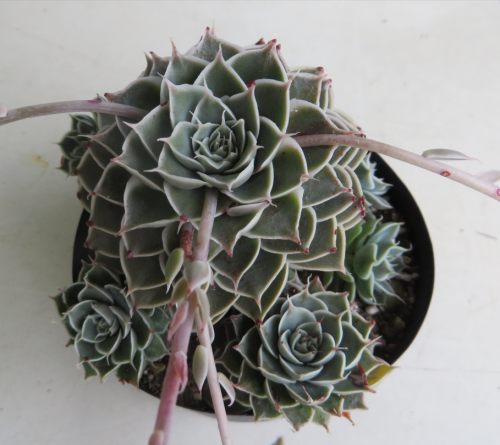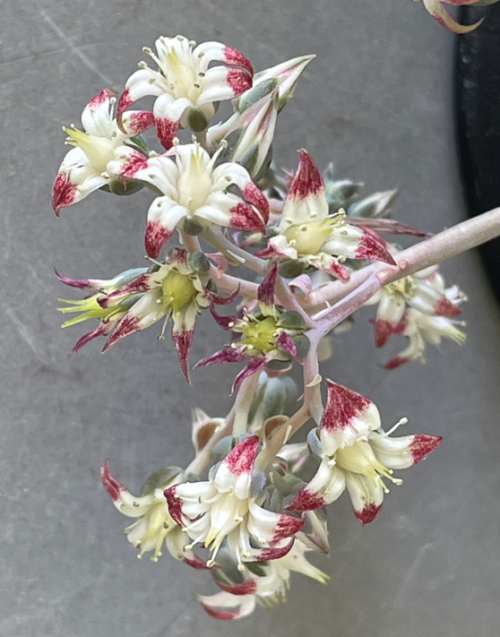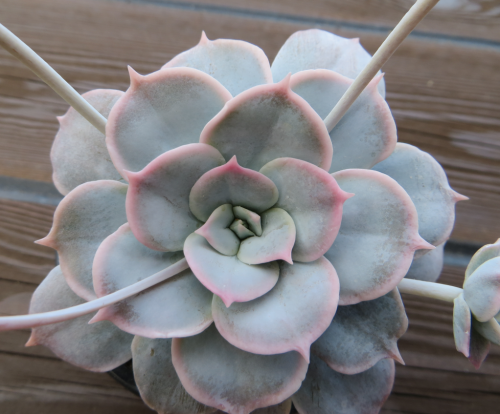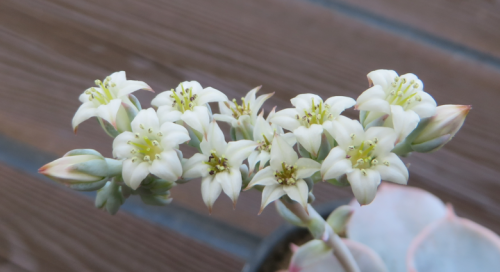Gerhard Koehres
A natural hybrid of Graptopetalum filiferum and Sedum sinforosanum.
Description of a several years old plant :
Perennial, glabrous plant, first solitary, with time offsetting from the lowest part of the stem.
Roots fibrous.
Rosette up to 8 cm diam., first acaulescent, with time forming a stem up to 5 cm long.
Leaves 60 and more, arranged in a dense rosette, to 3.3 cm long and almost 2 cm wide in upper third, obovate-spatulate, abruptly pointed with an up to 3 mm long bristle (in the youngest leaves 4.5 mm long, in older leaves no longer present), greyish-green with a 1 mm broad white margin, the latter sharp, somewhat hyaline.
Inflorescences 4, emerging from the upper part of the rosette, peduncle 7-9 cm long below the first branch with flowers, 2.5 mm diam. at base, very pale grey with a faint pinkish hue, bracts numerous, soon withering and falling off, lanceolate, to 1.1 cm long (incl. bristle), 4 mm wide, broadly attached to the peduncle, not spurred, same colour as leaves, also with a narrow white margin. Inflorescence an open cyme with up to four branches, each cincinnus with 9 or more flowers, light pinkish-grey, pedicels 6 mm long on lower flowers, shorter above, one bracteole at the base of the cincinni and at the base of the pedicels, soon withering and falling off, same colour as leaves.
Flowers : Sepals equal, appressed at corolla tube, 5 x 3 mm, lanceolate, same colour as leaves, free to the base, corolla tube 6.5 mm long, petals lanceolate, 11 x 3 mm, upper part of petals first spreading, later retrorse, white, in upper third covered in dark red graptos, filaments white, anthers yellowish white, nectar scales yellowish, carpels 11 mm high, white, styles 3 mm long, white.
The plant is named for Gerhard Köhres, in recognition of his services to the distribution of a large number of Mexican Crassulaceae by means of seeds.
Discussion
The hybrid has first been mentioned and illustrated by Julia Etter and Martin Kristen in the protologue of S. sinforosanum in Cactus and Succulent Journal US 89(4): 167, fig. 3. https://www.crassulaceae.com/botanik/pflanzen/scans/gnr1340/scan7/183615.pdf They had found it in the southwestern part of the Mexican state of Chihuahua among a population of Graptopetalum filiferum, growing not far from a small population of S. sinforosanum.
The hybrid strongly resembles Graptopetalum filiferum, differing mainly in lacking the long hair-like bristles of the basal leaves of the latter and having a not flattened rosette. Sedum sinforosanum is noticeable in the much shorter and less branched inflorescences of the hybrid and in the retrorse apices of its petals.
S. sinforosanum is similar to S. suaveolens. While the chromosome number of the former is not known, the latter is famous for its extraordinary high number of 2n = ± 640. This high number has the consequence that hybrids with S. suaveolens as one parent differ only insignificantly from the species [see xSedeveria 'Blue Lotus' (Echeveria elegans x S. suaveolens) https://www.crassulaceae.ch/de/artikel?akID=177&aaID=2&aiID=B&aID=123
and xS. 'Sehare' (S. suaveolens x E. secunda) https://www.crassulaceae.ch/de/artikel?akID=177&aaID=2&aiID=S&aID=5826
and even in xTacisedum 'Heswall' (Tacitus bellus x S. suaveolens) https://www.crassulaceae.ch/de/artikel?akID=197&aaID=2&aiID=H&aID=2457 the latter is dominant notwithstanding the comparatively high chromosome number of 2n = ± 204 of Tacitus.]
Because of the fact that S. sinforosanum and S. suaveolens are related it has been speculated that the former might have a similarly high chromosome number. xG. 'Gerhard Koehres' clearly disproves these speculations.
Margrit Bischofberger
First published in Sedum Society Newsletter14 : 8 - 10, Oct 2022.

.png)

Photos Margrit Bischofberger
The parents :
Graptopetalum filiferum :
.png)
.png)
Photos Gerhard Köhres
Sedum sinforosanum :


Photos Margrit Bischofberger